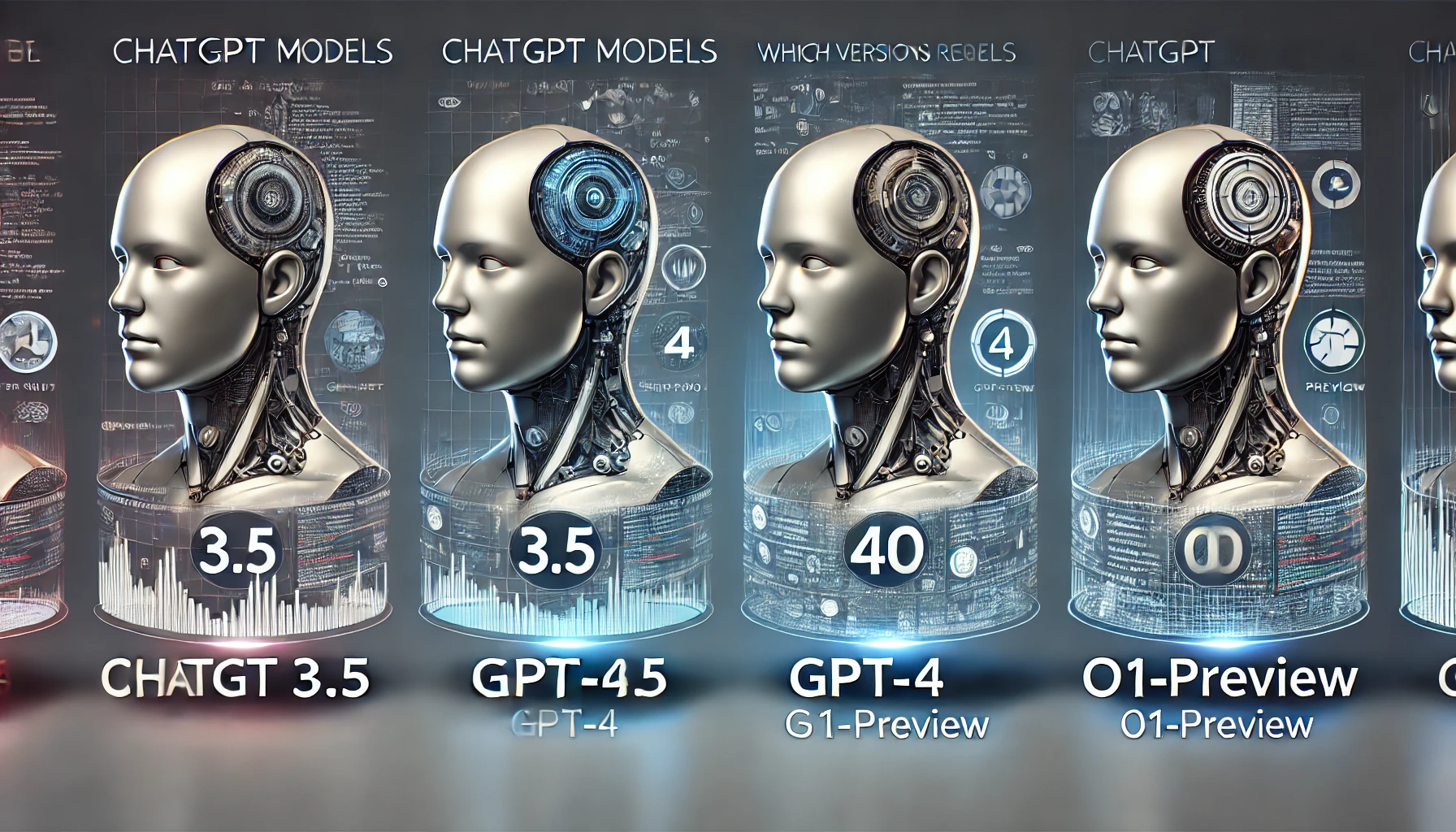ChatGPT 3.5 vs GPT-4 vs GPT-4o: Which Model is Best for Your Needs?
ChatGPT 3.5 vs GPT-4 vs GPT-4o: Choosing the right AI model can be a daunting task, especially when it comes to ChatGPT, where each version—ChatGPT 3.5, GPT-4, and GPT-4o—offers its unique capabilities. In this post, we’ll break down the differences between these models to help you decide which one is best for your specific needs. Whether you need advanced performance for complex tasks or just basic support, this comparison will provide insights into which version suits you.
Understanding the Evolution of ChatGPT Models
Since its launch, ChatGPT has evolved dramatically. Each iteration—ChatGPT 3.5, GPT-4, GPT-4o, and now GPT-4o mini—introduces new features and enhanced capabilities. Understanding the core differences between these models can help you pick the one that offers the best balance between performance, cost, and use case.
ChatGPT 3.5 vs GPT-4: What’s the Difference?
The jump from ChatGPT 3.5 to GPT-4 marked a significant upgrade. ChatGPT 3.5 was already a powerhouse for text generation, code writing, and answering questions, but GPT-4 introduced a higher level of contextual understanding, advanced reasoning capabilities, and better language comprehension.
Key Differences:
- Performance: GPT-4 is more powerful than ChatGPT 3.5 when it comes to complex reasoning and long-form content generation. It can handle nuanced and ambiguous prompts more effectively, making it ideal for sophisticated tasks like research, content creation, and problem-solving.
- Context Handling: GPT-4 has a larger context window compared to ChatGPT 3.5, meaning it can process longer conversations or documents without losing track of the topic.
- Creativity: If you require creative writing tasks, GPT-4 outperforms ChatGPT 3.5 due to its ability to generate more detailed, nuanced content.
Which to Choose?
For basic needs like short responses or light content creation, ChatGPT 3.5 is more than capable. However, if you need deeper context handling and more powerful reasoning, GPT-4 is the way to go.
GPT-4 vs GPT-4o: The Lightweight Alternative
GPT-4o is a more efficient version of GPT-4, offering a balance between performance and cost. The “o” stands for “optimized,” designed to be faster and less resource-intensive than the full GPT-4 model. But does this performance trade-off affect quality?
Key Differences:
- Speed: GPT-4o is quicker than GPT-4, making it ideal for real-time applications like chatbots and customer service where response speed is crucial.
- Cost-Effectiveness: Since GPT-4o uses fewer resources, it’s more cost-effective than the full GPT-4. This is particularly useful for businesses or developers looking to deploy AI without breaking the bank.
- Output Quality: Although GPT-4o is slightly less robust than GPT-4, it still handles most tasks impressively well. However, for highly complex or nuanced content, you might notice a dip in performance compared to the full version.
Which to Choose?
If speed and cost are your priorities, GPT-4o is a great alternative to GPT-4. For tasks requiring the utmost accuracy and reasoning, the full GPT-4 remains the better choice.
GPT-4o Mini: The Faster, Cost-Effective Solution
A smaller and more agile version of GPT-4o, GPT-4o mini is designed for scenarios where speed and efficiency are critical, but without sacrificing too much in terms of output quality.
Key Features:
- Speed: GPT-4o mini is faster than both GPT-4o and GPT-4, making it ideal for applications requiring rapid responses.
- Cost Efficiency: GPT-4o mini is the most cost-effective option, designed for high-volume use cases like customer support and real-time AI assistants.
- Narrow Focus: While it’s great for general-purpose tasks, GPT-4o mini may not be as strong for highly complex problems that require deep reasoning.
Which to Choose?
If you’re running a high-demand service with thousands of interactions daily, GPT-4o mini can save on costs without sacrificing too much quality. However, for more complex AI needs, you may want to stick with GPT-4o or GPT-4.
OpenAI o1-preview and o1-mini: What’s New?
OpenAI o1-preview and o1-mini are newer models optimized for coding, advanced problem-solving, and detailed writing tasks. They are built to handle complex queries that require more than just a basic response, such as advanced mathematics, coding, and in-depth content creation.
Key Differences:
- o1-preview is ideal for strategy ideation, coding exercises, and complex writing tasks. It’s capable of maintaining the structure and depth needed for intricate responses.
- o1-mini, on the other hand, is a more compact version of o1-preview, designed to be faster and more efficient while handling slightly simpler tasks. It’s great for quick debugging or providing summaries, though it lacks some of the broader world knowledge found in other models.
Which to Choose?
If your work involves coding or requires deeper strategic thinking, o1-preview is the model to go for. For faster, more straightforward tasks, o1-mini will get the job done efficiently.
Comparing Performance: When to Use GPT-4 vs o1-preview
For certain tasks, especially those involving advanced mathematical problems or detailed writing, both GPT-4 and o1-preview offer robust solutions. However, knowing when to use each model can save time and improve results.
Performance Breakdown:
- GPT-4: Best for creative writing, research papers, and long-form content generation. It excels in understanding context over extended conversations and documents.
- o1-preview: Tailored for more specialized tasks, such as coding, algorithmic problem-solving, and academic tutoring, where advanced reasoning is needed.
Which to Choose?
If you’re looking to generate engaging content or need extensive contextual understanding, GPT-4 is a great option. For coding tasks or mathematical exercises, o1-preview might be more suitable.
Which Model Fits Your Needs?
With so many versions of ChatGPT to choose from, understanding the differences between ChatGPT 3.5, GPT-4, GPT-4o, and OpenAI o1-preview and o1-mini is key to selecting the right tool for your projects.
General Content Creation:
- GPT-4: Best for high-quality content creation that requires a nuanced understanding of language.
- GPT-4o: A faster, cost-effective option for general content creation.
- GPT-4o mini: Ideal for rapid responses with lower costs, suitable for customer support or chatbots.
Complex Problem Solving:
- o1-preview: Excellent for coding, advanced reasoning, and complex problem-solving.
- o1-mini: A streamlined version for quicker tasks that don’t require deep contextual understanding.
By choosing the right model, you can optimize both performance and cost based on your specific needs. For more insights into using AI in different applications, visit Regent Studies.
External Link: For additional details on ChatGPT models, check out OpenAI’s ChatGPT Documentation.
Whether you’re choosing between GPT-4o, GPT-4, or newer models like o1-preview, understanding the key differences will help you select the model that best meets your needs.




